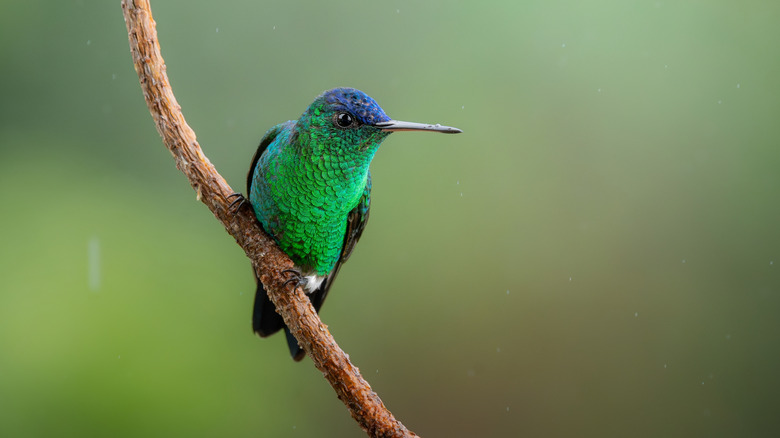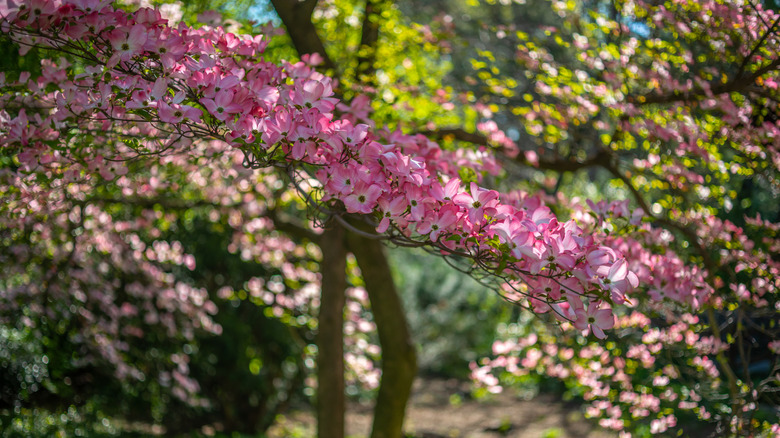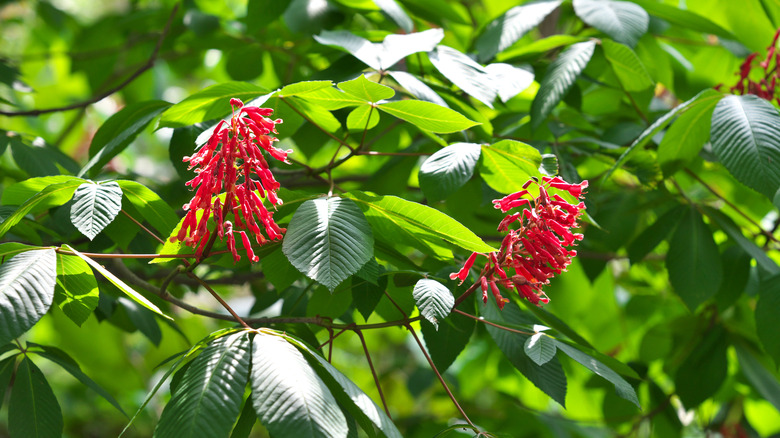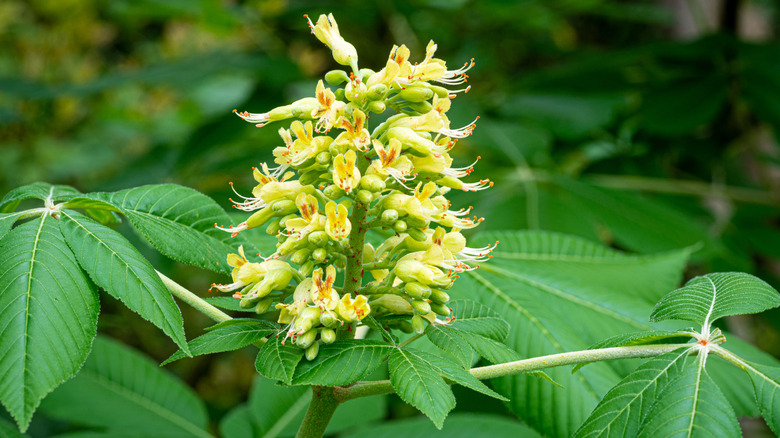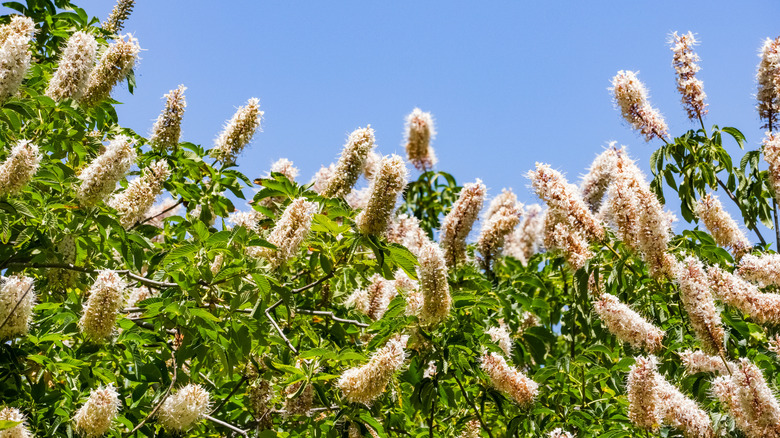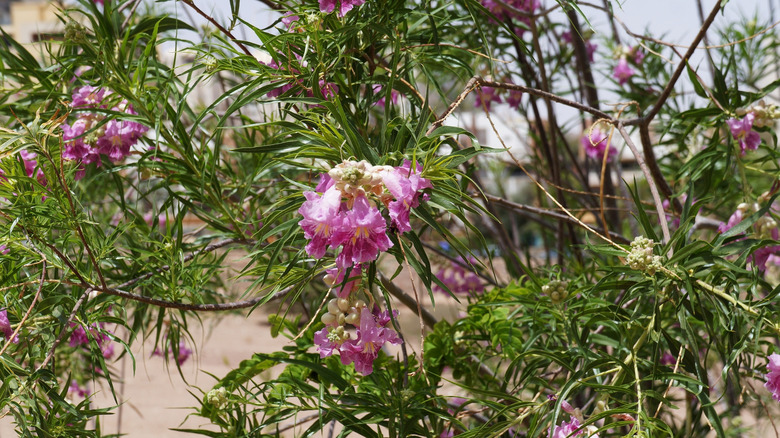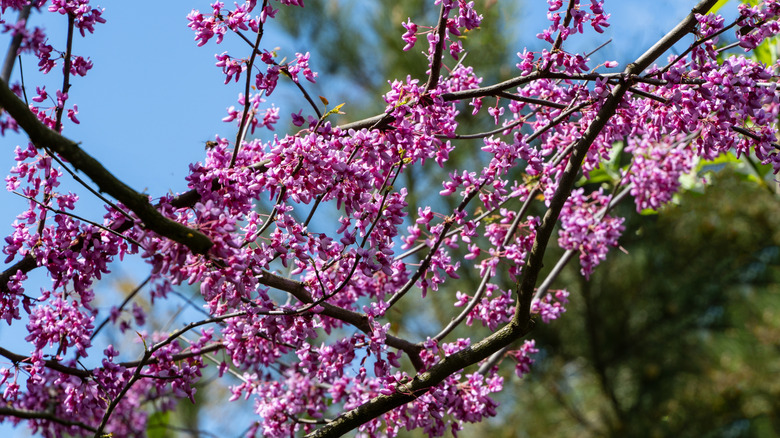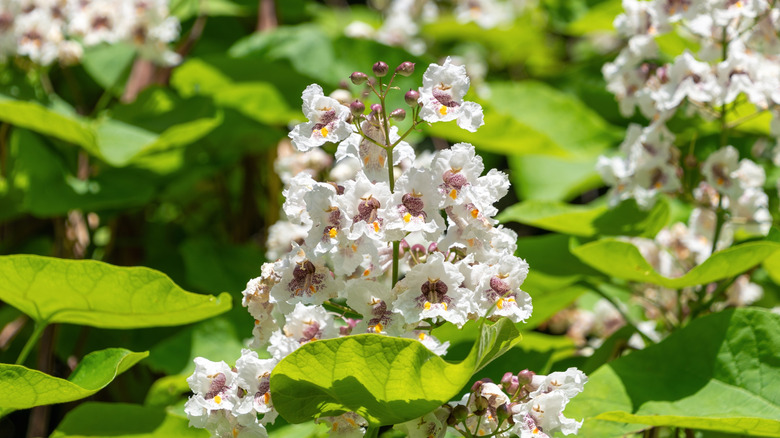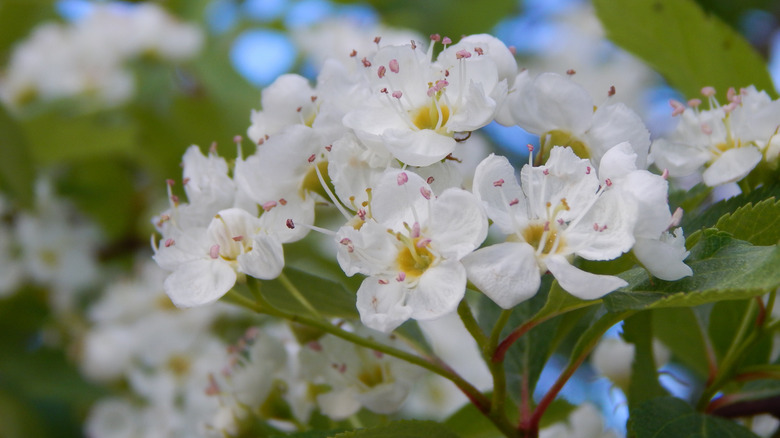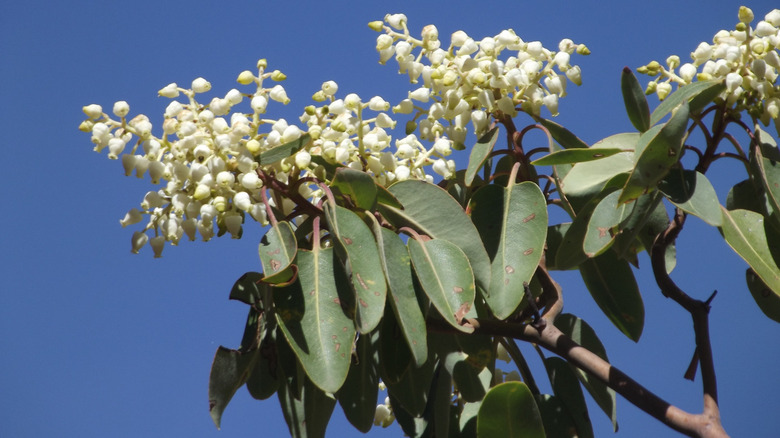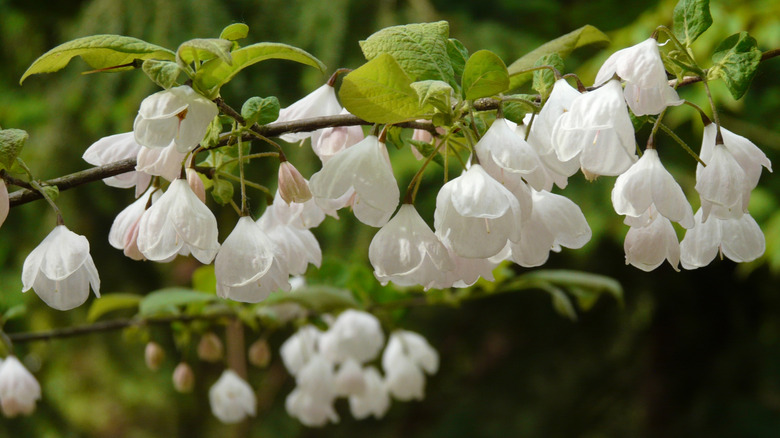10 Beautiful Trees To Naturally Invite Hummingbirds To Your Yard
Most gardeners know the excitement that comes with seeing a tiny hummingbird zip in and out of the yard. While feeders are a fantastic way to bring more of these fast-flying creatures onto the property, planting native flowering trees can sometimes be even more effective. Hummingbirds are drawn to tubular or funnel-shaped blooms that accommodate their long, slender beaks and tongues. Although red is often considered a hummingbird's favorite color, they'll visit flowers of almost any shade as long as they're rich in nectar. Additionally, many trees attract insects, which provide necessary protein for hummingbirds, especially the babies. Aside from food, trees provide cover for hummers seeking shelter, branches for perching, and sometimes even nesting sites.
While there are dozens of flowering trees that may encourage hummingbirds to stop by, native species are always best. Natives often produce blooms that are richer in nectar, which is what keeps our favorite tiny birds coming back time and time again. Native plants also provide habitat for a wide variety of native insects. Up to 80% of a hummingbird's diet is bugs, rather than nectar, so they'll likely favor yards crawling with their favorite protein sources. By planting a beautiful tree in your yard, you can provide nearly everything a hummingbird needs to thrive. Below are a few stunning native trees that are perfect for turning your yard into a hummingbird-friendly paradise.
Sweet crabapple provides hummingbirds with food and nesting sites
Hummingbirds spend a big chunk of their lives searching for nectar, often visiting over 1,000 flowers per day. Because they're constantly fueling their little bodies, a profusely blooming tree, like the sweet crabapple (Malus coronaria), is perfect for supplying them with a nearly endless supply of their main food source. In spring, this tree erupts with small, star-shaped flowers that easily catch the eye of little hummers flying by. Additionally, woodpeckers and other sap-suckers will leave behind sap wells after feeding, giving hummingbirds another sweet meal. This sticky liquid also attracts insects, another favorite food of hummingbirds. Crabapples are also great if you want to get more hummingbirds to nest in your yard, as ruby-throated hummingbirds will take advantage of the branches or cavities to raise their young.
Unlike some crabapples, the sweet crabapple is a beautiful, fragrant flowering tree that's native to the United States. It's generally low-maintenance and can tolerate a range of soil types and conditions, though it prefers moist, loamy, well-draining soils. Although you can plant it in a partially shaded area, it grows best when given full sun. As a member of the rose family, this tree is prone to some of the same common pests and diseases, so you'll want to keep an eye out for warning signs. It thrives in USDA hardiness zones 4 to 8, and can reach heights of up to 30 feet with a similar spread.
Red buckeye offers early-season nectar to hummingbirds
Depending on where you're located, you can expect hummingbirds to return to your area sometime in early spring, often as early as March in southern locations. By planting a red buckeye (Aesculus pavia) tree, you can welcome them back with bright red clusters of nectar-rich flowers that appear in March through April. Each flower is long and tube-shaped, providing the perfect entrance for a hummingbird's long, thin beak. Not only are the blooms a favorite of hummers, but red buckeye also provides a safe area for birds seeking cover.
Typically growing 15 to 20 feet tall and wide, red buckeye is a gorgeous, small tree that won't overtake your yard. In fact, you can even grow it as a shrub, depending on how you'd prefer to prune and train it. Hardy in Zones 4 to 8, this plant is happiest in a partially shaded area with some protection from the sun, as its leaves are prone to scorching during hot summer afternoons. So long as it's moist and well-draining, red buckeye can grow in many soil types. Unfortunately, it can be a messy tree with its leaf, stem, and fruit drop, so it's best to plant it away from patios, walkways, or other areas where cleanup could get annoying. It's also important to note that all parts of this plant are toxic when ingested, so it may not be the best option for those with curious little ones or pets in the home.
Ohio buckeye lures in hummingbirds with its profusion of spring blooms
While the Ohio buckeye (Aesculus glabra) may have yellowish-green blooms, rather than red, it's still a big hit with hummingbirds. Although hummingbirds can spot the color red more easily, it's flowers with high amounts of nectar that they'll smell and keep returning to. Luckily, they'll get plenty of food from this buckeye species in early spring, when it becomes covered in clusters of its nectar-rich, tubular blooms. You can also expect this tree to fill your garden with a variety of butterflies.
Plant the Ohio buckeye deep in rich, well-draining soil for best growth. Part shade is ideal, as its leaves are sensitive to extended periods of direct sunlight, especially if the soil becomes too dry. This buckeye can get much bigger than other species, reaching up to 40 feet tall and wide. Make sure to plant it in an area of your yard that you like, because its large taproot makes it extremely challenging to transplant once it grows. It's another messy plant, so it may not be the best choice for those who want to keep a tidy landscape. Like other buckeyes, Aesculus glabra is also poisonous to humans and pets, so plant it with caution. You can add this hummingbird-favorite tree to yards in Zones 3 to 7.
California buckeye's fragrant pink or white flower spikes attract hummingbirds
It's safe to say that hummingbirds can't resist most buckeye plants, and the California buckeye (Aesculus californica) is no exception. This small tree's fragrant white or pinkish flower spikes emerge in late spring or early summer, providing a buffet of nectar for these tiny birds. In addition to its showy flowers, this species also makes your yard a hummingbird nest-friendly habitat. The attractive gray bark is often decorated with lichen or moss, providing mama birds with some of their favorite materials they use for lining or camouflaging their nests.
As the only buckeye native to the state of California, this gorgeous variety thrives in Zones 7 to 8. California buckeye grows best in full sun to partial shade and well-draining soil, though it can thrive in a range of soil types and pH levels. It's a somewhat sensitive tree and needs to be in a protected area, as high winds, intense heat, or periods of drought can cause leaf drop. Like other buckeyes, you don't want to eat the nuts (or any parts of the tree), as the entire plant contains poisonous compounds that can be fatal if eaten by humans or pets.
Desert willow's nectar-rich blooms invite hummingbirds to your yard from spring to fall
If you want to attract hummingbirds with plants that thrive in dry climates, look no further than desert willow (Chilopsis linearis). This small, flowering tree produces catalpa-like, pink, tubular blooms that lure in beautiful hummingbirds, bees, and butterflies. The sweetly fragrant flowers last from spring to fall, providing pollinators with plenty of food for several months each year. It's also a larval host to the white-winged moth, so a hummingbird may also stop by to snag a few caterpillars for its hungry hatchlings.
Native to desert-like habitats, desert willow is a low-maintenance species that tolerates drought and can grow well even in dry, poor soils. Hardy in Zones 7 to 11, it grows best in a sunny area and can withstand intense summer heat. Although it doesn't have many insect or disease issues, its self-seeding habit can make it somewhat weedy. Additionally, the fallen seeds, flowers, and leaves can create litter that may be a nuisance to clean up. Because its wood can be brittle, regular pruning can help maintain a strong form.
Eastern redbud attracts hummingbirds with its dense branches and rosy flower clusters
Eastern redbud (Cercis canadensis) is a gorgeous understory tree that is sure to bring more pollinators into your yard or garden. The main draw for hummingbirds is its profuse clusters of rosy pink or light purple flowers that emerge on bare branches in early spring. Butterflies, bees, and other beneficial insects will also gather around the blooms. Additionally, it's a host plant for over a dozen butterfly and moth species, so hummers will have their pick of protein-rich caterpillars to eat or feed their babies. In addition to its abundance of hummingbird food, redbuds also provide the tiny birds with safe branches for resting and cover to hide from predators or harsh weather.
You can grow eastern redbud as a colorful ornamental in Zones 4 to 9, where it looks beautiful, whether planted in small groups or as a specimen plant. Although generally low-maintenance, it can be a little sensitive and needs the right conditions to thrive. It's easily grown in full sun to part shade in most well-draining soil types, though it cannot withstand drought, overly wet conditions, or intense heat. Once established, it will reach 20 to 30 feet tall and up to 35 feet wide, though there are several more compact cultivars to choose from. This tree doesn't tolerate root disturbance, so it's best to choose its planting site carefully and avoid transplanting.
Southern catalpa gives hummingbirds a buffet of flowers and insects
The southern catalpa (Catalpa bignonioides) is a fast-growing shade tree that hummingbirds and other pollinators can't get enough of. It's a showy summer-bloomer that puts out clusters of white, bell-shaped flowers adorned with purple and yellow markings in the throats. Hummers and bees are particularly fond of these fragrant blooms, and it also serves as a host plant to two native moths. While caterpillars and other insects can damage the foliage, this is rarely an issue in a hummingbird-friendly yard, since the birds will happily use them to fuel up on protein.
You can use the southern catalpa to add more shade and attract hummingbirds to your yard in Zones 5 to 9. It's relatively low-maintenance, tolerating most soil types and conditions, and easily grown in full sun to part shade. Naturally growing near rivers and streams, it works well for a rain garden or for growing near a water feature, which can also attract and benefit hummingbirds, as they tend to stick around and nest in areas that are near water. This medium-sized tree can grow up to 60 feet tall, though dwarf cultivars are available for smaller yards. Because it has an irregular crown, it won't suit formal gardens, though its unique shape depends on your personal preference. Its mature branches can become brittle, and the large leaves can also be damaged by wind or storms, which can create litter or make the tree look tattered.
Black hawthorn offers hummingbirds protective cover and nectar-rich blooms
For those who enjoy the thrill of observing wildlife in their own backyard, you can't go wrong with a black hawthorn (Crataegus douglasii) tree. In late spring to early summer, it produces dense clusters of white, cup-shaped flowers that are like magnets to hummingbirds and bees. As its common name implies, it has sharp thorns growing along the branches, which gives birds and other animals protection against predators. Paired with its dense growth, the black hawthorn offers a safe space for hummingbirds and other small animals to seek cover. Its winter berries are edible, and what you don't eat and leave on the tree will attract more songbirds to your yard.
Black hawthorn is a hardy and low-maintenance plant that's easily grown in Zones 4 to 8. It's tolerant of most soils, even growing in heavy clay soils. Although it can grow in part shade, you'll get the best fruit production if you plant it in a sunny area. One downside of this tree is its fragrant flowers. While this trait may seem like a bonus, the scent is often compared to decaying fish, which helps it to attract pollinators. It can sometimes grow more shrubby and form thickets, so you'll need to prune in late winter to control its growth. It's somewhat susceptible to fungal diseases like powdery mildew and leaf spot, and pests including aphids and caterpillars. Luckily, hummingbirds will likely do their part to control insect populations.
Pacific madrone's bell-shaped flowers are favored by hummingbirds
Although the Pacific madrone's (Arbutus menziesii) creamy white flowers are beautiful, its bark is one of its most remarkable features. It has papery, reddish-brown exfoliating bark that peels back in thin sheets to reveal a smooth copper-toned layer underneath. This doesn't just add to its attractiveness, but hummingbirds, particularly broad-tailed hummingbirds, may also use the fallen bark pieces to build their nests. Its clusters of small, bell-shaped flowers that emerge in spring are highly attractive to returning hummingbirds.
Plant Pacific madrone trees in well-draining, dry soils in partial shade to full sun for best growth. When growing in regions with dry, hot summers, this species benefits from being planted in an area with some protection from the afternoon sun. They prefer low-fertility soils, so be careful not to over-fertilize. It has a massive root system, which is why it's often used to control erosion in some yards. However, this trait can also make it potentially damaging to foundations, so make sure to give it plenty of room to grow. It may be slow-growing, but it can reach up to 65 feet tall and 50 feet wide, so it'll need plenty of space to expand. It's another species that doesn't like to be transplanted, so choose its location carefully. This tree makes a great addition to a bird garden in Zones 7 to 9.
Carolina silverbell supplies hummingbirds with native insects and an abundance of bell-shaped flowers
Carolina silverbell (Halesia carolina) is another stunning native tree that you'll love growing if you enjoy attracting wildlife. Its white or pink-tinged, bell-shaped flowers appear in spring, providing early-season nectar for hummingbirds, bees, butterflies, and other pollinators. It's a host plant for several butterfly and moth species, which means more protein for hummingbirds. The flowers give way to their showy, copper fruits, which add visual interest that often persists into winter.
While Carolina silverbell can grow in a sunny area, it prefers a partially shady site with rich, acidic to neutral soil. It naturally grows along creek banks and other moist areas, so it needs regular moisture and won't tolerate heat, drought, or compacted soil. This tree typically grows up to 35 feet tall, sometimes taller, so make sure your yard has room for its mature size. There are a few smaller cultivars, though some tend to take on more of a shrubby appearance. No matter which one you choose, you'll need to train it to maintain a tree shape. It makes a gorgeous specimen plant or rain garden tree in Zones 4 to 8.
